
Back in December of 2016, I was asked by my friend and mentor, the late Doug Little, if I’d like to be part of a brand new blog on his St. Johns River Eco Tours website. I thought it sounded like a lot of fun, and was honored to be invited to create some nature-related posts for him, in a series called Notes From the River.
Now that my Bird Nerd friend, Dennis Burnette, has joined me here at The Write Stuff with his own nature-related posts, I thought it would also be fun to share some of the ones I did for Doug’s blog now and then, too. I’m starting this off with one I hope you’ll all enjoy.
#NotesFromTheRiver:
When Is a Little Blue Heron NOT a Little Blue Heron?
When It’s a Calico Heron, That’s When!
Today, I’m going to share some lesser known information about the Little Blue Heron, and yep, that’s one above, even though most photos show little blues looking like this:
Adult Little Blue Heron
The truth is that even though little blue herons end up a solid, slate blue, with a purplish cast to the neck, just like the picture above, they ALL start out white. See? The bird in this next photo is also a little blue heron, but in juvenile plumage.
Immature Little Blue Heron
When little blue herons fledge (leave the nest), they are solid white birds, which means they are often misidentified as snowy egrets or cattle egrets. Only their smaller size keeps them from being pointed out as great egrets, as well. But if you look closely, you see immature little blue herons have greenish yellow legs, and blue-grey beaks with a dark tip. Snowy egrets have black legs with golden yellow feet and black beaks, and cattle egrets, which are usually seen in fields and pastures rather than wading along the water’s edge, have bright yellow legs and beaks.
As you might imagine, if the bird starts off white, and ends up dark blue-grey, there must be an intermediate stage to get from this:
Juvenile Little Blue Heron
To this: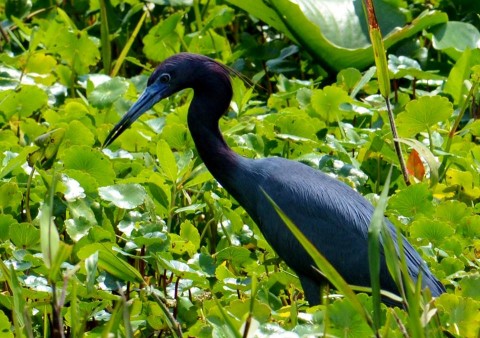
Adult Little Blue Heron
Et voila! Here’s the aforementioned intermediate stage!
A Juvenile Little Blue Heron Molting
into Adult Plumage
(Again, this is the stage when they are often called calico herons.)
Little Blue Heron Range Map
As you can see, the little blue heron is a wide-spread bird, and breeds throughout large portions of the southeastern United States. They are very common birds, with no current population issues, which means birders have a good chance of spotting them any time they are on or near freshwater ponds, lakes, marshes, swamps, and rivers. They are sometimes found on marine coastlines, as well.
So, if you want to add this bird to your life list, you probably won’t have to go to any great lengths to find adult specimens. And the white juvenile birds are often easy to spot, as well. But if you’re hoping to photograph them in the calico stage, you might have to hunt a little longer, and at the right time of year. It’s an in-between stage, after all, and doesn’t last forever. As you can see in the next photo, the blue gray adult plumage on this bird is definitely taking over from the white. Won’t be long before it looks just like mom and dad.
A collective of herons is known as a battery, a hedge, a pose, a rookery, and a scattering. Take your pick.
I’m hedging my bets with “hedge.”
Little blue herons are medium sized waders, standing about 2 feet tall, with a wingspan of around 40 inches.They eat a variety of fish, insects, and various other invertebrates, including crayfish, like the one below.
Hapless “Mudbug” About To Go to Crawdad Heaven.
These birds are colony nesters, quite happy to join other egrets and herons, including cattle egrets, which is interesting, because those are not even native to North America. Little blues lay as many as six pale, blue green eggs at a time, which they incubate for 22 to 24 days, before the eggs hatch into some rather scruffy chicks, sporting some seriously punkish spiked “hair.”
From this . . .
To this . . .
. . . then this . . .
and finally, THIS!
Adult Little Blue Heron
And there you have it, folks. Hope you enjoyed learning a bit more about this common, but very beautiful, heron. Keep your eyes open when out on the rivers and lakes, and maybe you’ll spot that equally beautiful, in-between stage, known as the calico heron.
NOTE: This post with Doug’s photos first appeared on the
St. Johns River Eco Tours blog here:
When Is a Little Blue Heron Not a Little Blue Heron?
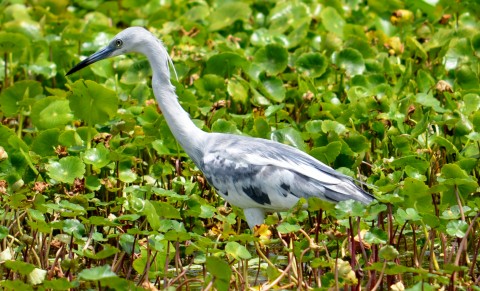
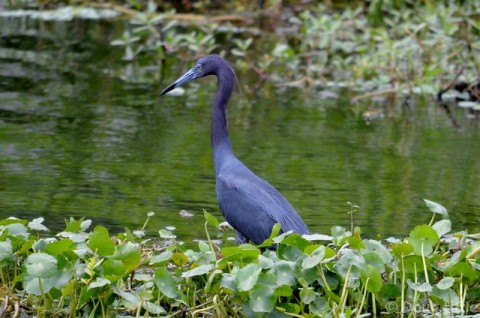
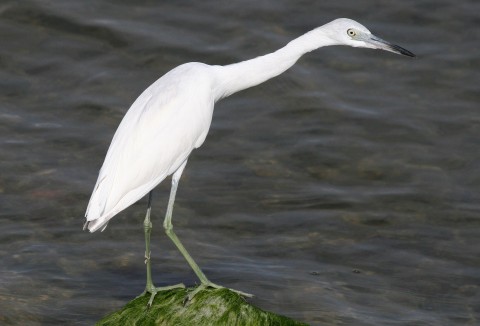
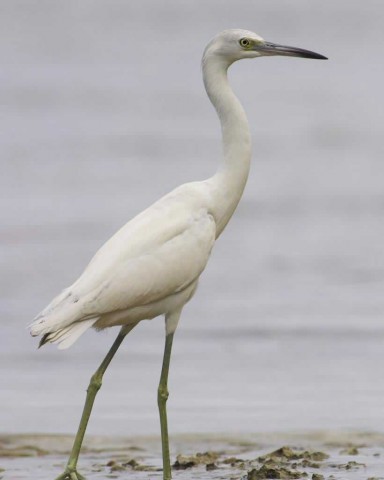
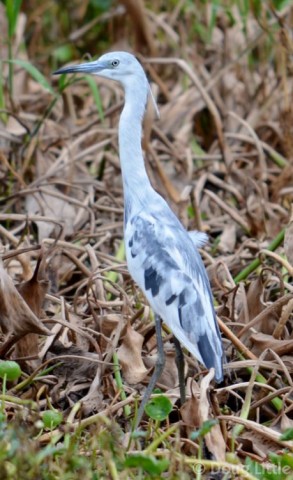
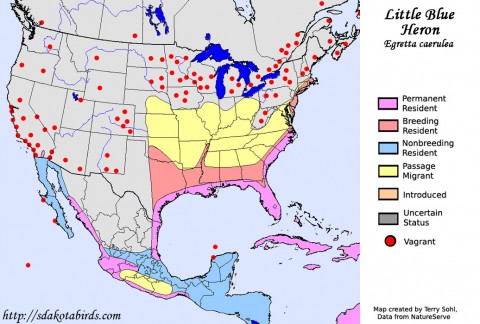
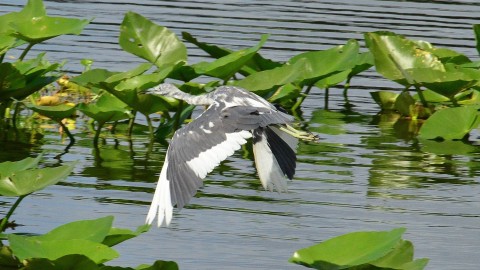

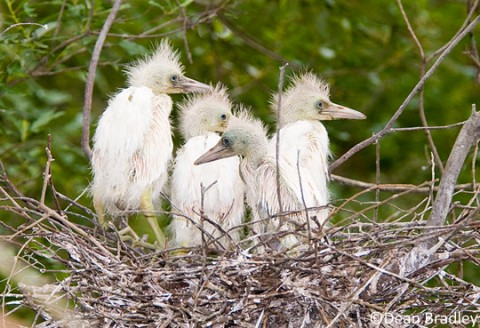
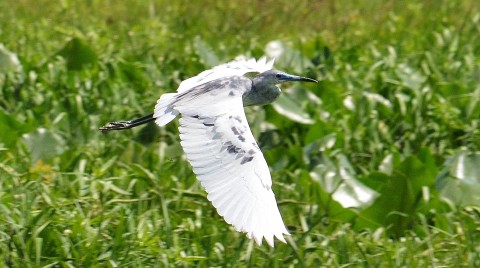
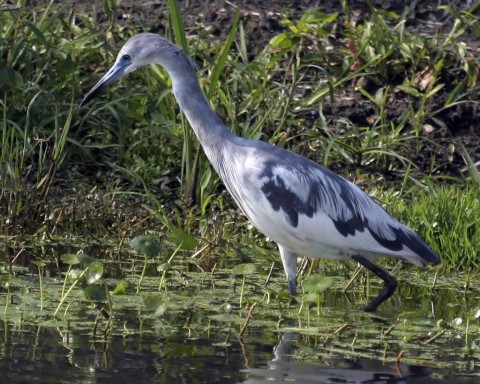
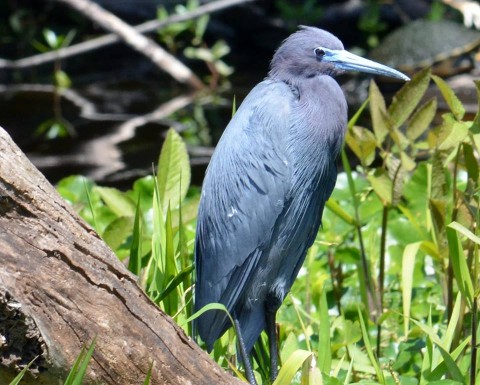

I love these birds. We did see them in the Vancouver area too. Their transformation is amazing. Thanks.
LikeLiked by 1 person
They are beautiful birds, aren’t they? And the range map definitely shows a couple of red dots above the Canadian border, though they are considered “vagrants” up there. I’m glad you enjoyed this post, Darlene, and I appreciate your stopping by to let me know. Enjoy the rest of your week, my friend! 😀 ❤
LikeLiked by 1 person
Thank you for this lovely hedge of herons!
LikeLiked by 1 person
You are most welcome, Jackie! I’m glad you enjoyed reading about them, and I appreciate your stopping by to let me know. Happy travels ahead! 😀 ❤
LikeLiked by 1 person
As far as I’m aware we don’t get Blue Herons in the UK so this was lovely to see. Thanks, Marcia 💚
LikeLiked by 1 person
I think you’re right about that, Cathy. From what I’ve read, they are found in North America, Central American, South America, and the West Indies. Sorry they haven’t yet made it across the pond, but I hope you get to see some of them someday. They are truly handsome little guys. Over time, I’ll be posting about their cousins, Great Blue Herons, and the rest of the herons and egrets we have around here. Hope you’ll enjoy reading about them, too.
Thanks for stopping by and taking a moment to share your thoughts! Now go forth and have a super rest of the week! 😀 ❤
LikeLiked by 1 person
They look wonderful, a stunning colour. I’m sure I’ll enjoy all your wildlife posts, Marcia.
Thank you, hope the rest of your week is a good one 🥰
LikeLiked by 1 person
🤗❤️🤗
LikeLiked by 1 person
I don’t live in the right area, and don’t think I’ve ever seen one.
LikeLiked by 1 person
I’m sorry you don’t get to enjoy them like we do down here, Craig, but it looks like they are “vagrants” in your part of the world. That limits your chances of spotting one considerably, but it’s still possible, anyway. Hope one crosses your path someday, as they are such pretty little guys.
Thanks for stopping by and taking a moment to comment, and here’s to a great rest of the week! 😀
LikeLiked by 1 person
Interesting post, Marcia. Thanks for sharing. I’ve seen white herons around here before (I think they are herons) but now I wonder if they might be one of these.
LikeLiked by 1 person
Glad you enjoyed it, Jeanne. There are several white herons and egrets, so it’s hard to tell what you’ve seen by color alone. Beak and leg color are helpful pointers, as is size. These guys are pretty small, compared to great egrets and great white herons, more comparable to snowy egrets and cattle egrets. It’s easier to ID them in their adult plumage, I think.
Thanks so much for stopping by today and taking a moment to comment, Jeanne. Hope the rest of your week goes great! 😀 ❤
LikeLiked by 1 person
I had no idea herons changed colors as they grew. Beautiful at any stage!
LikeLiked by 1 person
Glad you enjoyed the post, Vera, and happy to share the calico herons with you. Not all herons go through a change quite like this one, but it isn’t rare for immature birds of many species to be colored differently from the adults and have to molt into that adult plumage.
We have six species of herons here in Florida (now that they’ve decided the great white heron is a morph of the great blue, instead of a separate species) and four species of egrets, so lots of beautiful wading birds to admire. Hope you’ll stay tuned for more over the weeks ahead.
Thanks so much for stopping by today and taking a moment to say hello. Have a super rest of the week! 😀 ❤
LikeLiked by 1 person
Just a little FYI, I saw a piece on our Bay News 9 just the other day about St John’s River Eco Tours. They said his nephew now runs the tours and are still going strong. I was very happy to see that the family is carrying on Doug’s legacy.
LikeLiked by 1 person
I just recently found that out, too, Jackie. His niece took care of Doug while he was so sick, and happily, her husband has now taken over the tours. I’m so glad they will be ongoing, and I know it would have made Doug very happy, too.
When I’m released from house arrest, one of the first things I plan to do (if it’s cooler out by then) is go on the tour, myself. The blog is still active, so I think linking to some of these older posts will help get the word out for them, too.
Thanks for stopping by today, Jackie, and for sharing with me. I’m glad to hear it was announced on Bay News! That’s great! 😀 ❤
LikeLiked by 1 person
I’ve seen several herons biking on an Ohio towpath trail along the Cuyahoga River but none were blue. I would guess they’re a different type, or I’d have eventually seen a little blue through the years of biking on this trail. Great information and great pics! Thanks, Marcia!
LikeLiked by 1 person
Looks like even vagrant Little Blues aren’t usually seen in Ohio, Nancy, though Pennsylvania appears to get a few. Great Blue Herons are more common up your way, though “blue” is relative. To me, they look more gray. They are also much taller than the little blues. You might have seen them now and then. I plan to do a post on them, and all of the other wading birds as this series progresses, though I may alternate with other types of birds and wildlife. Hope you’ll enjoy them, and thanks so much for stopping by and taking a moment to say hello. Have a great rest of the week! 😀 ❤
LikeLike
Yes, the herons I see near the Cuyahoga River are very big and more grey in color. I’ve been illuminated! Thanks for clarifying, Marcia!
LikeLiked by 1 person
Glad I could help clear it up, Nancy. Great blues are impressive and beautiful, for sure! Thanks again for visiting today. 😀 ❤
LikeLiked by 1 person
Nice write up of an interesting color “phase” of Little Blue Heron plumage. Also, a great collection of photos that illustrate the “calico” plumage well. Little blues at one time were thought to be a separate species. Your friend Doug was a talented photographer! And for folks who haven’t spent much time in the southeastern United States, this also is a good place to mention that we have two different species of “blue herons.” The one in this write up, as you point out, is a Little Blue Heron. The other species is the Great Blue Heron. Two very interesting bird species!
LikeLiked by 1 person
Good to see you here today, Dennis, and thanks for the compliments. Yep, the Lumpers and the Splitters have worked on herons, too, saying that some are separate species, then deciding otherwise. Plus, in general, new things are learned about our wildlife every day, so I tried to check to see if any info had changed since I wrote this post in 2016.
I did mention in one or two responses above that I’ll be doing a post on Great Blue herons in the future, along with all the other wading birds I love, but I’ll probably alternate with other bird species and animals, just to keep things interesting.
And I agree about Doug’s photography skill. (He would have loved YOUR work, too.) Honestly, if you go out on eco-tours every day of the week for years and years, you get a LOT of opportunities for great pics, but there’s talent involved, too, with both of you. I could never take pictures like Doug’s or yours, and I’m so lucky to have you for a friend, and to have had Doug for one, too.
Thanks for stopping by today, and I’m glad you enjoyed the post and pictures. Have a great rest of the week! 😀
LikeLike
I have not seen one, but I love the blue color they end up. Great information, hopefully I will see one someday and now know what it is 🙂
LikeLiked by 1 person
I hope you have an opportunity to spot one, too, Denise. They are lovely, and fun to watch, and they aren’t even my VERY FAVORITE wading bird. (That one’s coming along later! 😁)
I’m glad you enjoyed the post, and hope this series will continue to appeal to you over the weeks ahead. Thanks so much for stopping by and taking a moment to say hello! Have a great rest of the week. 😀 ❤
LikeLiked by 1 person
Excellent post, Marcia. we loved the Herons when we lived on the coast.
LikeLiked by 1 person
These are primarily fresh water waders, John, so you might see them around various lakes or streams in your area. (If you have any nearby). I’ve seen various wading birds in salt water now and then, but not as often as along our rivers, etc.
Glad you enjoyed the post, and hope you get to see some of these guys in the future. Thanks for stopping by, and here’s to a great rest of the week! 😀 ❤
LikeLiked by 1 person
We loved the Great Blue Herons. They would walk the beach and beg for bait from the fishermen
LikeLiked by 1 person
I love them, too. They are so majestic, and they like rivers, streams, gulfs, oceans, you name it. Much easier to spot them, too, since they’re so tall. Glad you’ve enjoyed them in the past, and hope you come across some lakes or other bodies of water in your area where you can still see them now and then. 😊
LikeLiked by 1 person
I’d never heard of Little Blue Herons before, let-alone seen a picture of one. You’re great at pointing out the distinguinshing features to look for and I’m fairly confident I could spot a Calico one if I was in your area. I don’t think I’d have any problem identifying the adult Little Blue Heron after seeing that amazing blue/purple colour combination – if only I didn’t live the other side of the pond! Many thanks, Marcia. ❤
LikeLiked by 1 person
I’m so glad you enjoyed learning a bit about one of our wading birds, Trish. I’m sorry you don’t have them in your part of the world, but then again, you have a lot of birds over there we don’t get a chance to see here, so I guess it all evens out. And if you’re ever in “my area,” I promise I’ll be sure to point little blue herons out to you, along with all sorts of other birds and wildlife! 😁
Thanks so much for stopping by today and sharing your thoughts. Now go enjoy some of your backyard birds that I’d give anything to see someday, and I’ll try not to be jealous! 😂❤️😂
LikeLiked by 1 person
❤️😂❤️
LikeLiked by 1 person
Love these birds! Here’s a tidbit that’ll blow your mind. There is no blue pigment in any bird feather. Blue birds have melanin, which is brown. Light-shifting particles on the barbs of the feathers make them appear blue to us.
LikeLiked by 1 person
Glad you enjoyed the post, Sue, and funny you should mention the lack of blue pigment. I do a talk that includes that information, and you should see the look on the audience faces when I tell them there’s no such thing as an actual blue bird. It’s sort of amazing, isn’t it? Especially since some of our birds that appear to be blue are EXTREMELY brilliant to our eyes. Hard to imagine it’s all refracted light, huh?
I will probably go into that in another post here, at some point. I’m glad you reminded me of it. Thanks for stopping by, and I hope you enjoyed the “blue”/calico herons featured today. 😀 ❤
LikeLiked by 1 person
We occasionally see a bird flying overhead that has a sleek body, long beak, large wingspan, and stick legs that poke out the back. We jokingly call this a pterodactyl, and I wonder if it is a heron. It’s a treat to see one fly above.
LikeLiked by 1 person
Most of the larger wading birds fit that general description, Jennie, though they vary in color, but your use of the term pterodactyl makes me suspect you are seeing a wood stork. They are largely white, with wide black edging along the wings, and a very heavy (massive) dark beak, and fly with their necks stretched out.
The herons and egrets fly with their necks pulled back against their bodies or in a loose “S” shape. They are shades of gray, or solid white (egret), and have long but slender beaks.
Sandhill cranes are gray and fly with their necks stretched out, have slender beaks, and a bit of red on their heads.
Hope this helps. (My money’s on the wood stork. Google for a picture and see if it looks right to you. ) 😀
LikeLiked by 1 person
Thank you, Marcia. I will look up wood storks.
LikeLiked by 1 person
I had no idea that these birds changed color. Thanks for all the information. These blogs are so interesting 🙂
LikeLiked by 1 person
So glad you learned something new, Debra, and that it was interesting to you.
In general, lots of immature birds have plumage that’s different from the adult bird. Cardinals come to mind right away. Males are red with an orange beak, females are brown, with an orange beak, and young birds are brown, too, but their beaks are black.
As this series goes along, I plan to share lots of fun things I’ve learned over the years, so I hope you’ll stay tuned.
Thanks for stopping by and taking the time to comment, too. Have a great weekend! 😀 ❤
LikeLiked by 1 person
I love them!!! My favorite is that last picture where they look “all bunched up”. 🙂
LikeLiked by 1 person
I’m glad you enjoyed the post, and hope you can now tell the difference in an immature, a calico, and a mature little blue heron, Sue. Such a nice transition from fledgling to adult. And I like that last picture, too. Herons often stand (and fly) with their long necks pulled in against their bodies. It makes for a handsome photo, for sure.
Thanks for stopping by and taking a moment to share your thoughts. 😀 ❤
LikeLike